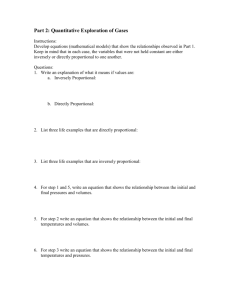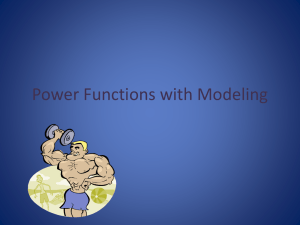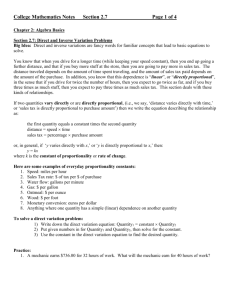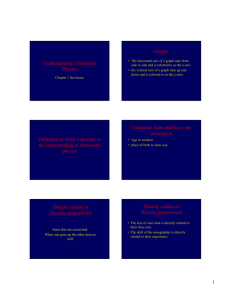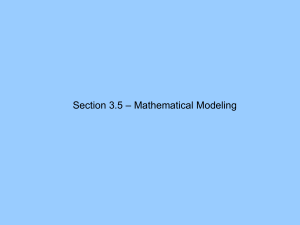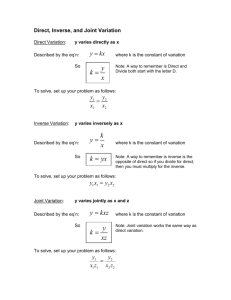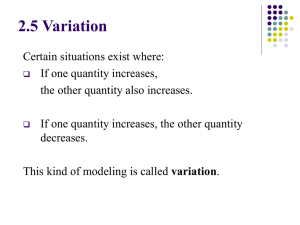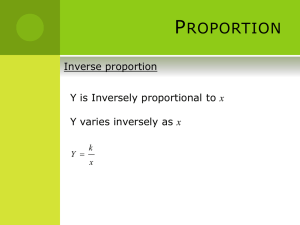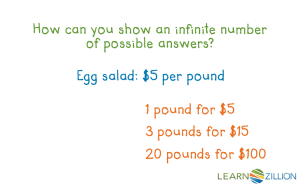Notes
advertisement
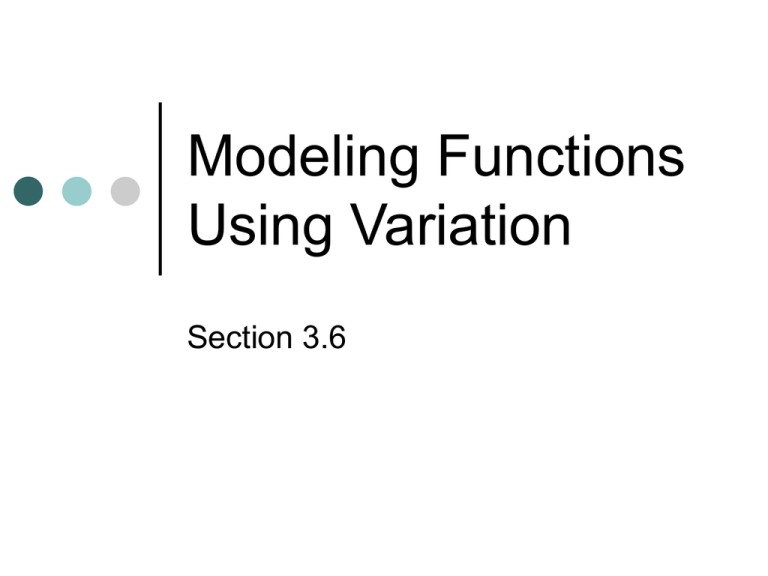
Modeling Functions Using Variation Section 3.6 Direct Variation Let x and y represent two quantities. The following are equivalent statements: y = kx, where k is a nonzero constant. y varies directly with x. y is directly proportional to x. The constant k is called the constant of variation or the constant of proportionality. Write an equation that describes variation. V varies directly with x³ V=kx³ z varies directly with m z=km y is directly proportional to the square root of x y=k x Write an equation to represent the variation. W is directly proportional to the cube of H. W = 128 and H = 4 W kH 3 128 k 4 3 128 64 k 2k Plug the k-value back into original. W 2H 3 Inverse Variation Let x and y represent two quantities. The following are equivalent statements: k y= , where k is a nonzero constant. x y varies inversely with x. y is inversely proportional to x. The constant k is called the constant of variation or the constant of proportionality. NOTE: For inverse variation we see that when the x increases, the y decreases or visa versa. Write an equation that describes variation. f varies inversely with c f= k c A varies inversely with t A= k t y is inversely proportional to the cube of x y= k x3 Write an equation to represent the variation. y varies inversely with x. y = 400 and x = 1000. k y x k 400 1000 400,000 k 400 ,000 y x Joint Variation When one quantity is proportional to the product of two or more other quantities, it is called Joint Variation. I is directly proportional to P, r and t. For example: I = Prt which represents the simple interest formula where: I is the interest in dollars P is the principal (initial) dollars r is the interest rate (decimal form) t is the time in years Write an equation to describe the variation. A is directly proportional to both b and h. A = 10 when b = 5 and h = 4. A kbh 10 k 5 4 10 20 k 1 k 2 1 A bh 2 Write an equation to represent the variation. F varies inversely with both λ and L. F = 20π when λ = 1 and L = 100 k F L k 20 1 100 2000 k 2000 F L Combined Variation When the variation is mixed, this is called Combined Variation. P is directly proportional to T and inversely proportional to V. T V For example: P = k which represents the combined gas law in chemistry. P is pressure T is temperature V is volume k is a gas constant Example of Direct Variation Find a mathematical model describing the monthly long distance bill if the cost is directly proportional to the number of minutes, and a customer that used 160 minutes is billed $40. 1. Declare your variables: 2. Set up your direct variation equation and solve for the constant of variation: C = km 3. c = is the cost in dollars m = the number minutes 40 = k(160) ¼ =k Solution: c = ¼ m This equation describes the relationship between number of minutes and cost. They are directly proportional. Example of Inverse Variation In New York City, the number of potential buyers in the housing market is inversely proportional to the price of a house. If there are 12,500 potential buyers for a $2 million condominium, how many potential buyers are there for a $5 million condominium? 1. Declare your variables: p = price of a house b = potential buyers k b p 2. Set up your inverse variation equation and solve for the constant of variation: k 12500 = 2000000 2.5 X 1010 = k 3. Inverse variation equation: b = 2.5 X 1010 p How many potential buyers are there for a $5,000,000 condo? 10 2 . 5 X 10 4. Solution: b = 5000000 b = 5000 There are 5000 potential buyers for condos at $5,000,000. 2.5 X 1010 b p Levi’s makes jeans in a variety of price ranges for men. The Silver Tab Baggy jeans sell for about $30, and they are trying to figure out how much to sell the Offender jeans for. The demand for Levi’s jeans is inversely proportional to the price. If 400,000 pairs of the Silver Tab jeans were bought, and they have 150,000 pairs of Offender jeans to sell, what should they list the price at for the Offenders? k d p k 400 ,000 30 12,000,000 k 12,000,000 d p 12,000,000 150,000 p 150,000p 12,000,000 p 80 $80 for Offenders The gas in the headspace of a soda bottle has a volume of 9.0mL, pressure of 2 atm, and a temperature of 298 K. If the soda bottle is stored in a refrigerator, the temperature drops to approximately 279 K. What is the pressure of the gas in the headspace once the bottle is chilled? T Pk V 298 2k 9 18 k 298 18 T P 298 V 18 279 P 298 9 P 1.87 About 1.87 atm
